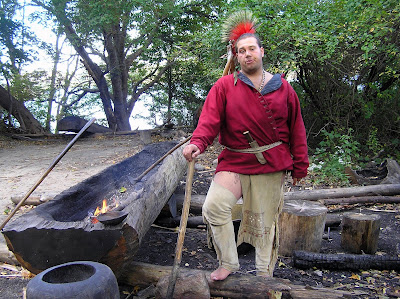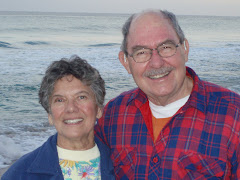
The airplane shown below is also an early airplane, when designers were still working on making machines that would fly. This plane also just taxied. Note the skids that worked with the wheels to keep the plane off the ground. The very earliest planes had only skids -- no wheels.
I believe, although I am a little unsure the airplane below, is a Spade -- a bulwark of the French and British in World War I. This plane did fly during the airshow.
There was also a Sopworth Camel at the aerodrome, but it did not fly. We were told by one of the pilots, it was tricky to fly, because the setting for the spark advance, choke and accelerator,was never the same from flight to flight, and it toke an experienced pilot to adjust all three at once, while trying to gain speed to take off. The Camel also had a rotary engine -- the whole engine rotated with the propeller on a fixed crankshaft. This lead to the development of a huge amount of torque, and could lead to the plane spinning rather than the propeller --- not a good prescription for a long life of the pilot.
After visiting the Aerodrome, we spend a day at Hyde park, visiting Roosevelt's home. I discussed our visit in our previous blog, but suffice to say, if you plan a visit -- consider taking a day and a half to see everything ( introductory film, Presidential Library, Eleanor's Cottage, FDR's getaway cottage, Vanderbilt Mansion). FDR's and Eleanor Roosevelt's grave is shown in the picture below.
We are now in South Carolina, having just completed servicing our RV. We also visited the nearby Kings Mountain National Battlefield, which is in South Carolina, just over the state line from North Carolina. This was the site of an important Revolutionary War battle, in which the Tories (aka Loyalist), loyal to Great Britain, led by British officers were soundly defeated by Americans, mostly who were quickly recruited from backwoodsmen from North Carolina and Virginia.( The American fighter are now called Patriots, in the brochure describing the battle.) This battle was decisive, because it was the end of any loyalist military support from people living in the colonies, for the British. The Loyalist either decided to support the new Revolutionary government or fled to New Brunswick.
There is always something to be learned from the study of past wars. The battle of King Mountain shows how difficult it is , if not impossible, for an invading troops to win a guerrilla war, even with some support and training of the indigenous population. The invaders are essentially getting involved in a Civil War, which they are powerless to control, unless they are willing to engage in genocide. (Nuf' said --End of lesson for today.)












